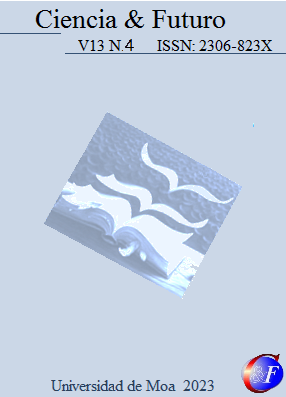Emotional, cognitive, and social spheres of frontal and prefrontal lobe syndrome
Keywords:
prefrontal cortex, motor cortex, frontal syndromes, dysexecutive syndromesAbstract
There are many potential reasons of frontal lobule syndromes that include traumatic cerebral injuries, cerebral-vascular accidents, tumors, infections, and degenerative affections. In order to know the main signs of frontal and prefrontal syndromes, a review was carried out depending on the types of injury, etiology, and place. Options for treatment will depend on the cause and can include medicaments, behavioral therapy, and other forms of rehabilitation.Downloads
References
Buxbaum, L. J. & Coslett, H. B. (2009). Apraxia: Sensory System. Encyclopedia of Neuroscience, 553–559. https://doi.org/10.1016/B978-008045046-9.00551-9.
Catani, M. (2019). The anatomy of the human frontal lobe. Handbook of Clinical Neurology, 163, 95–122. https://doi.org/10.1016/B978-0-12-804281-6.00006-9.
Clark, D. L., Boutros, N. N. & Mendez, M. F. (2018). Frontal Lobe. The Brain and Behavior, 73–102. https://doi.org/10.1017/9781108164320.007.
Felten, M. S. & Felten, D. L. (2019). Netter: cuaderno de neurociencia para colorear. Elsevier.
Haque, H., Lobier, M., Palva, J. M. & Palva, S. (2020). Neuronal correlates of full and partial visual conscious perception. Consciousness and Cognition, 78, 102863. https://doi.org/10.1016/J.CONCOG.2019.102863.
Hardwick, R. M., Rottschy, C., Miall, R. C. & Eickhoff, S. B. (2013). A quantitative meta-analysis and review of motor learning in the human brain. NeuroImage, 67, 283–297. https://doi.org/10.1016/J.NEUROIMAGE.2012.11.020.
Heilman K. M. (2021). Upper Limb Apraxia. Continuum (Minneapolis, Minn.), 27(6), 1602–1623. https://doi.org/10.1212/CON.0000000000001014.
Henri-Bhargava, A., Stuss, D. T. & Freedman, M. (2018). Clinical Assessment of Prefrontal Lobe Functions. CONTINUUM Lifelong Learning in Neurology, 24(3, BEHAVIORAL NEUROLOGY AND PSYCHIATRY), 704–726. https://doi.org/10.1212/CON.0000000000000609.
Jones, D. T., & Graff, J. (2021). Executive Dysfunction and the Prefrontal Cortex. Continuum (Minneapolis, Minn.), 27(6), 1586–1601. https://doi.org/10.1212/CON.00000000000001009.
Jumah, F. R. and Dossani, R. H. (2022). Neuroanatomy, Cingulate Cortex. StatPearls. https://www.ncbi.nlm.nih.gov/books/NBK537077/.
Kensinger, E. A. & Ford, J. H. (2021). Guiding the Emotion in Emotional Memories: The Role of the Dorsomedial Prefrontal Cortex. Current Directions in Psychological Science, 30(2), 111–119. https://doi.org/10.1177/0963721421990081/ASSET/IMAGES/LARGE/10.1177_0963721421990081-FIG2.JPEG.
Lau, H. C., Rogers, R. D., Haggard, P. & Passingham, R. E. (2004). Attention to Intention. Science, 303(5661), 1208–1210. https://doi.org/10.1126/SCIENCE.1090973/SUPPL_FILE/LAU.SOM.PDF.
Lázaro, J., Ostrosky, F. & Lozano, A. (2008). Batería de funciones frontales ejecutivas. Presentación. Revista neuropsicología, neuropsiquiatría y neurociencias, 8(1), 141-158. http://revistaneurociencias.com/index.php/RNNN/article/view/233.
Park, J. E. (2017). Apraxia: RevieRehabilitación neuropsicológica en paciente con traumatismo craneoencefálico por daño cerebral sobrevenido. Estudio de casow and Update. Journal of Clinical Neurology (Seoul, Korea), 13(4), 317. https://doi.org/10.3988/JCN.2017.13.4.317
Purdy, M. H. (2022). Aphasia, alexia, and agraphia. Reference Module in Neuroscience and Biobehavioral Psychology. https://doi.org/10.1016/B978-0-323-91497-0.00083-7.
Reber, J. & Tranel, D. (2019). Frontal lobe syndromes. Handbook of clinical neurology, 163, 147–164. https://doi.org/10.1016/B978-0-12-804281-6.00008-2.
Rushworth, M. F. S., Noonan, M. A. P., Boorman, E. D., Walton, M. E. and Behrens, T. E. (2011). Frontal Cortex and Reward-Guided Learning and Decision-Making. Neuron, 70(6), 1054–1069. https://doi.org/10.1016/J.NEURON.2011.05.014.
Salehinejad, M. A., Ghanavati, E., Rashid, M. H. A. and Nitsche, M. A. (2021). Hot and cold executive functions in the brain: A prefrontal-cingular network. Brain and Neuroscience Advances, 5, 239821282110077. https://doi.org/10.1177/23982128211007769.
Sescousse, G., Redouté, J. & Dreher, J. C. (2010). The Architecture of Reward Value Coding in the Human Orbitofrontal Cortex. Journal of Neuroscience, 30(39), 13095–13104. https://doi.org/10.1523/JNEUROSCI.3501-10.2010.
Silva, M. & Ramos, C. (2021). Etiología del daño Cerebral: un aporte neuropsicológico en su construcción teórica (primera parte). Revista Ecuatoriana de Neurología, 30(1), 154-165. https://doi.org/10.46997/revecuatneurol.30100154.
Suzuki, Y. & Tanaka, S. C. (2021). Functions of the ventromedial prefrontal cortex in emotion regulation under stress. Scientific Reports, 11(1). https://doi.org/10.1038/s41598-021-97751-0.
Tiu, J. B. & Carter, A. R. (2022). Agraphia. Encyclopedia of the Neurological Sciences, 86–88. https://doi.org/10.1016/B978-0-12-385157-4.00466-8.
Wang, Y., Du, W., Yang, X., Yan, J., Sun, W., Bai, J., Zhou, J., Zhou, A., Niu, J., Li, C. & Wang, J. (2021). Diagnosis and differential diagnosis flow diagram of Chinese post-stroke aphasia types and treatment of post-stroke aphasia. Aging Medicine, 4(4), 325–336. https://doi.org/10.1002/AGM2.12183.
Published
How to Cite
Issue
Section

This work is licensed under a Creative Commons Attribution-NonCommercial 4.0 International License.
Esta obra está bajo una Licencia Creative Commons Reconocimiento-NoComercial 4.0 Internacional
La Revista Ciencia & Futuro es una revista de acceso abierto, todo el contenido está disponible gratuitamente sin cargo para el usuario o su institución. Los usuarios pueden leer, descargar, copiar, distribuir, imprimir, buscar o vincular los textos completos de los artículos, o utilizarlos para cualquier otro fin lícito, sin pedir permiso previo al editor o al autor. Todo lo anterior, de acuerdo con la definición de BOAI de acceso abierto.
Los autores que publican en esta revista están de acuerdo con los siguientes términos: Licencia Creative Commons Atribución-NoComercial permite que el beneficiario de la licencia tenga el derecho de copiar, distribuir, exhibir y representar la obra y hacer obras derivadas para fines no comerciales siempre y cuando reconozca y cite la obra de la forma especificada por el autor o el licenciante. Los autores pueden establecer por separado acuerdos adicionales para la distribución no exclusiva de la versión de la obra publicada en la revista (por ejemplo, situarlo en un repositorio institucional o publicarlo en un libro), con un reconocimiento de su publicación inicial en esta revista. Se permite y se anima a los autores a difundir sus trabajos electrónicamente (por ejemplo, en repositorios institucionales o en su propio sitio web) antes y durante el proceso de envío, ya que puede dar lugar a intercambios productivos, así como a una citación más temprana y mayor de los trabajos publicados (Véase The Effect of Open Access) (en inglés). Lo anterior debe realizarse siempre sobre el artículo ya publicado por Ciencia & Futuro.
Los autores mantienen el control sobre la integridad de sus trabajos y el derecho a ser adecuadamente reconocidos y citados.
A los editores se les otorgan derechos no exclusivos para publicar y distribuir.






